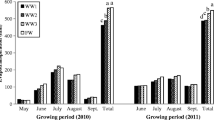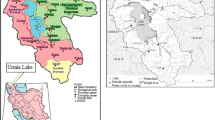Abstract
In recent years, using wastewater, such as fish farming effluent, has been increased, especially in developing countries. Therefore, this research aimed to investigate the effect of three types of irrigation water including river water, fish farm water, and mixed water (50% river water + 50% fish farm effluent) on growth rates and concentrations of macro- and micronutrients in basil and purslane. The experiment was conducted in a randomized complete block design with three replications. Results indicated that irrigation with fish farm effluent significantly increased the fresh and dry weight of shoot and root, leaf number, and stem height in both plants. In the fish farm treatment, the fresh weight of shoots increased 203% and 250% compared to river water irrigation, in basil and purslane, respectively. Concentrations of N, P, K, Cu, and Mn in basil increased significantly in fish farm treatment compared to river water irrigation. Also, concentrations of N, P, Mg, and Cu in purslane increased in fish water treatment. In both plants, river water irrigation significantly enhanced Ca and Zn concentrations. Therefore, using fish farm effluent in irrigation provides water requirement of plants and also can improve the availability of nutrient elements for basil and purslane.


Similar content being viewed by others
References
Qadir M, Wichelns D, Raschid-Sally L, McCornick PG, Drechsel P, Bahri A, Minhas PS (2010) The challenges of wastewater irrigation in developing countries. Agric Water Manag 97:561–568
Jimenez B (2006) Irrigation in developing countries using waste water. Int Rev Environ Strateg 6(2):229–250
Khater EG, Bahnasawya AH, Shamsa AES (2015) Utilization of effluent fish farms in tomato cultivation. Ecol Eng 83:199–207
Soltani V, Jafari A, Kalami K, Vazifeshenas MM (2017) Effect of diluted saline water on some vegetative and physiological traits of pomegranate rooted cutting cv. Malas-e Yazdi. J Plant Prod Res 24(3):1–11
Castro RS, Azevedo CMB, Bezerra-Net F (2006) Increasing yield of cherry tomato using fish effluent as irrigation water in Northeast Brazil. Sci Hortic 110(1):44–50
de Melo Ribeiro FH, Naval LP (2019) Reuse alternatives for effluents from the fish processing industry through multi-criteria analysis. J Clean Prod 227:336–345
Haquea MM, Belton B, Mehedi Alamd MD, Golzar Ahmed A, Rushna Alama Md (2016) Reuse of fish pond sediment as fertilizer for fodder grass production in Bangladesh: potential for sustainable intensification and improved nutrition. Agric Ecosyst Environ 216:226–236
McMurtry MR, Sanderas D, Cure JD, Hodson RG, Haninc BC, Amand ST (1997) Efficiency of water use of an integrated fish vegetable co-culture system. J World Aquac Soc 28(4):420–428
Valencia E, Adjei M, Martin J (2001) Aquaculture effluent as a water and nutrient source for hay production in seasonally dry tropics. Commun Field Sci Plant Anal 32(7–8):1293–1301
Crews TE, Peoples MB (2004) Legumes versus fertilizer sources of nitrogen: ecological tradeoffs and human needs. Agric Ecosyst Environ 102:279–297
Cordell D, White S (2011) Peak phosphorus: clarifying the key issue of a vigorous debate on long-term phosphorus security. Sustainability 3:2027–2049
Palada MC, Cole WM, Crossman SMA (1999) Effect of effluents from intensive aquaculture and sludge on growth and yield of bell peppers. Agriculture 14:85–103
Shpigel MA, Neori D, Popper M, Gordon H (1993) A proposed model for “environmental clean” land-based culture of fish, bivalves and seaweeds. Aquaculture 117:115–128
Holby O, Hall POJ (1991) Chemical fluxes and mass balances in a marine fish cage farm. II. Phosphorous. Mar Ecol Progress Ser 70:263–272
Chapell JA, Brown TW, Purcell T (2008) A demonstration of tilapia and tomato culture using an energy-efficient integrated system approach. From the pharaohs to the future. In: Proceedings of the 8th international symposium on Tilapia in aquaculture. Cairo, Egypt, pp 201–215
Hundley GMC, Navarro RD, Figueiredo CMG, Navarro FKSP, Pereira MM, Ribeiro Filho OP, Seixas Filho JT (2013) Aproveitamento do efluente da produção de tilápia do Nilo para o crescimento de manjericão (Origanum basilicum) e manjerona (Origanum majorana) em sistemas de aquaponia. Revista Brasileira de Agropecuaria Sustentavel 3(1):51–55
Rocha AF, Biazzetti Filho ML, Stech MR, Silva RP (2017) Lettuce production in aquaponic and biofloc systems with silver catfish Rhamdia quelen. Boletim do Instituto de Pesca 44:64–73
Silva EFL, Botelho HA, Venceslau AFA, Magalhaes DS (2018) Fish farming effluent application in the development and growth of maize and bean plants. Cientifica Jaboticabal 46(1):74–81
Abdelraouf R (2017) Reuse of fish farm drainage water in irrigation. In: The handbook of environmental chemistry. Springer, Berlin
Martinez LA, Buschmann AH (1996) Agar yield and quality of Gracilaria chilensis (Gigartinales, Rhodophyta) in tank culture using fish effluents. Hydrobiologia 326(327):341–345
Soundy P, Cantliffe DJ, Hochmuth GJ, Stofella PY (2001) Nutrient requirements for lettuce transplants using a floatation irrigation system. Hortic Sci 36:1066–1070
Makri O, Kintzios S (2008) Ocimum sp. (basil): botany, cultivation, pharmaceutical properties, and biotechnology. Journal of Herbs Spices and Medicinal Plants 13:123–150
Schuman M (2001) Over view of purslane edible and medicinal herb. NNFA. Today 15(6):12
Karla YP (1998) Reference methods for plant analysis. CRC Press, Boca Raton
Cyrino JEP, Bicudo AJA, Sado RY, Borghesi R, Dairiki JK (2010) A piscicultura o ambiente - o uso de ali-mentos ambientalmente corretis em piscicultura. Revista Brasileira de Zootecnia 39:68–87
Paulus D, Toffoli E, Eduardo Pereira Ramos C, de Moura C, Becker D, Francio I (2019) Potential use of eucalyptus seedling in recycling of fish farming wastewater in agriculture. J Exp Agric Int 36:1–11
Gibson JL (2005) Quantifying waste excretion by the Egyptian tilapia hybrid (Oreochromis niloticus) and nutrient uptake by hydroponically grown plant species to optimize an integrated aquaculture system. Canada. Master’s thesis, Queen’s University, Ontario
Graber A, Junge R (2009) Aquaponic systems nutrient recycling from fish wastewater by vegetable production. Desalination, Presented at Multi Functions of Wetland Systems. In: International conference of multiple roles of wetlands, Legnardo (Padova) Italy, 246. pp. 147–156
Heenan DP, Campbell LC (1981) Influence of potassium and manganese on growth and uptake of magnesium by soybean (Glycin max (L.) Merr Cv Bragg). Plant Soil 61:447–456
Luangprasert N (1996) Effects of granular and foliage fertilization on the quality and yield of Tioga strawberry grown in degraded soil in petchaboon province. Kasetsart 30:409–413
Singh N, Tasung A, Tripathi S, Baldev Patel P, Mulchand Bafna A, Govind Pat R (2015) Aquaculture effluent: effect on yield, nutrient content and uptake in Salicornia bachiata Roxb. J Aquac Res Dev 6:376
Álvarez-García M, Urrestarazu M, Guil-Guerrero JL, Jiménez-Becker S (2019) Effect of fertigation using fish production wastewater on Pelargonium x zonale growth and nutrient content. Agric Water Manag 223:105762
Acknowledgements
The authors are grateful to the Vali-e-Asr University of Rafsanjan, for providing some facilities.
Author information
Authors and Affiliations
Corresponding author
Ethics declarations
Conflict of interest
The authors declare that they have no conflict of interest to publish the manuscript.
Additional information
Publisher's Note
Springer Nature remains neutral with regard to jurisdictional claims in published maps and institutional affiliations.
Significance Statement
Due to water shortages, new sources of irrigation are needed. The plants used in this study have a high value for medicines and nutrition. Therefore, the findings of this research are applicable to the pharmaceutical and agricultural industries.
Rights and permissions
About this article
Cite this article
Kaab Omeir, M., Jafari, A., Shirmardi, M. et al. Effects of Irrigation with Fish Farm Effluent on Nutrient Content of Basil and Purslane. Proc. Natl. Acad. Sci., India, Sect. B Biol. Sci. 90, 825–831 (2020). https://doi.org/10.1007/s40011-019-01155-0
Received:
Revised:
Accepted:
Published:
Issue Date:
DOI: https://doi.org/10.1007/s40011-019-01155-0




